check engine VOLVO XC70 2003 Owners Manual
[x] Cancel search | Manufacturer: VOLVO, Model Year: 2003, Model line: XC70, Model: VOLVO XC70 2003Pages: 257, PDF Size: 5.33 MB
Page 4 of 257
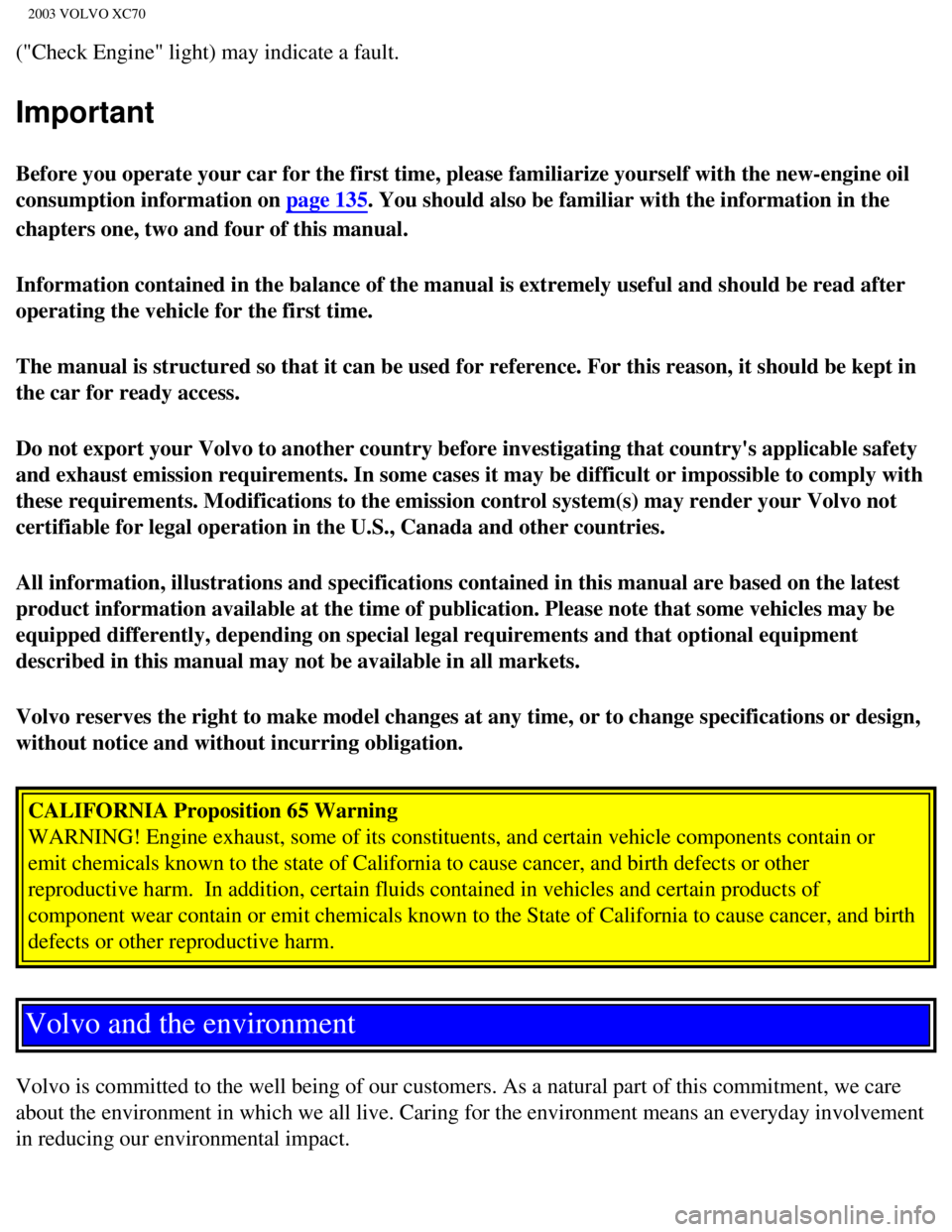
2003 VOLVO XC70
("Check Engine" light) may indicate a fault.
Important
Before you operate your car for the first time, please familiarize yours\
elf with the new-engine oil
consumption information on
page 135. You should also be familiar with the information in the
chapters one, two and four of this manual.
Information contained in the balance of the manual is extremely useful a\
nd should be read after
operating the vehicle for the first time.
The manual is structured so that it can be used for reference. For this \
reason, it should be kept in
the car for ready access.
Do not export your Volvo to another country before investigating that co\
untry's applicable safety
and exhaust emission requirements. In some cases it may be difficult or \
impossible to comply with
these requirements. Modifications to the emission control system(s) ma\
y render your Volvo not
certifiable for legal operation in the U.S., Canada and other countries.\
All information, illustrations and specifications contained in this manu\
al are based on the latest
product information available at the time of publication. Please note th\
at some vehicles may be
equipped differently, depending on special legal requirements and that o\
ptional equipment
described in this manual may not be available in all markets.
Volvo reserves the right to make model changes at any time, or to change\
specifications or design,
without notice and without incurring obligation.
CALIFORNIA Proposition 65 Warning
WARNING! Engine exhaust, some of its constituents, and certain vehicle c\
omponents contain or
emit chemicals known to the state of California to cause cancer, and bir\
th defects or other
reproductive harm. In addition, certain fluids contained in vehicles an\
d certain products of
component wear contain or emit chemicals known to the State of Californi\
a to cause cancer, and birth
defects or other reproductive harm.
Volvo and the environment
Volvo is committed to the well being of our customers. As a natural part\
of this commitment, we care
about the environment in which we all live. Caring for the environment m\
eans an everyday involvement
in reducing our environmental impact.
file:///K|/ownersdocs/2003/2003_XC70/03xc70_00.htm (4 of 6)12/30/2006 \
4:17:50 PM
Page 5 of 257

2003 VOLVO XC70
Volvo's environmental activities are based on a holistic view, which mea\
ns we consider the overall
environmental impact of a product throughout its complete life cycle. In\
this context, design, production,
product use, and recycling are all important considerations.
In production, Volvo has partly or completely phased out several chemica\
ls including freons, lead
chromates, naphtanates, asbestos, mercury and cadmium; and reduced the a\
mount of chemicals used in
our plants 50% since 1991.
In use, Volvo was the first in the world to introduce into production a \
three-way catalytic converter with
a Lambda sond, now called oxygen sensor, in 1976. The current version of\
this highly efficient system
reduces emissions of harmful substances (CO, HC, NOx) from the exhaust\
pipe by approximately 95%
and the search to eliminate the remaining emissions continues. Volvo is \
the only automobile
manufacturer to offer CFC-free retrofit kits for the air conditioning sy\
stem for all models as far back as
the M/Y 1975 240. Advanced electronic engine controls, refined purificat\
ion systems and cleaner fuels
are bringing us closer to our goal.
After Volvo cars and parts have fulfilled their use, recycling is the ne\
xt critical step in completing the
life cycle. The metal content is about 75% of the total weight of a car,\
which makes the car among the
most recycled industrial products. In order to have efficient and well c\
ontrolled recycling, many Volvo
variants have printed dismantling manuals, indicating the weight and mat\
erial of individual components.
For Volvo, all homogeneous plastic parts weighing more than 1.7 oz. (50\
grams) are marked with
international symbols that indicate how the component is to be sorted fo\
r recycling.
In addition to continuous environmental refinement of conventional gasol\
ine-powered internal
combustion engines, Volvo is actively looking at advanced technology alt\
ernative-fuel vehicles.
When you drive a Volvo, you become our partner in the work to lessen the\
car's impact on the
environment.
To reduce your vehicle's environmental impact, you can:
l Maintain proper air pressure in your tires. Tests have shown decreased f\
uel economy with improperly
inflated tires
l Follow the recommended maintenance schedule
l Drive at a constant speed
l See an authorized Volvo retailer as soon as possible for inspection if t\
he check engine (malfunction
indicator) lamp illuminates, or stays on after the vehicle has started \
l Properly dispose of any vehicle related waste such as used motor oil, us\
ed batteries, brake pads, etc.
l When cleaning your car, use Volvo's own car care products, all of which \
have systematically been
adapted to the environment
PremAir®
file:///K|/ownersdocs/2003/2003_XC70/03xc70_00.htm (5 of 6)12/30/2006 \
4:17:50 PM
Page 13 of 257
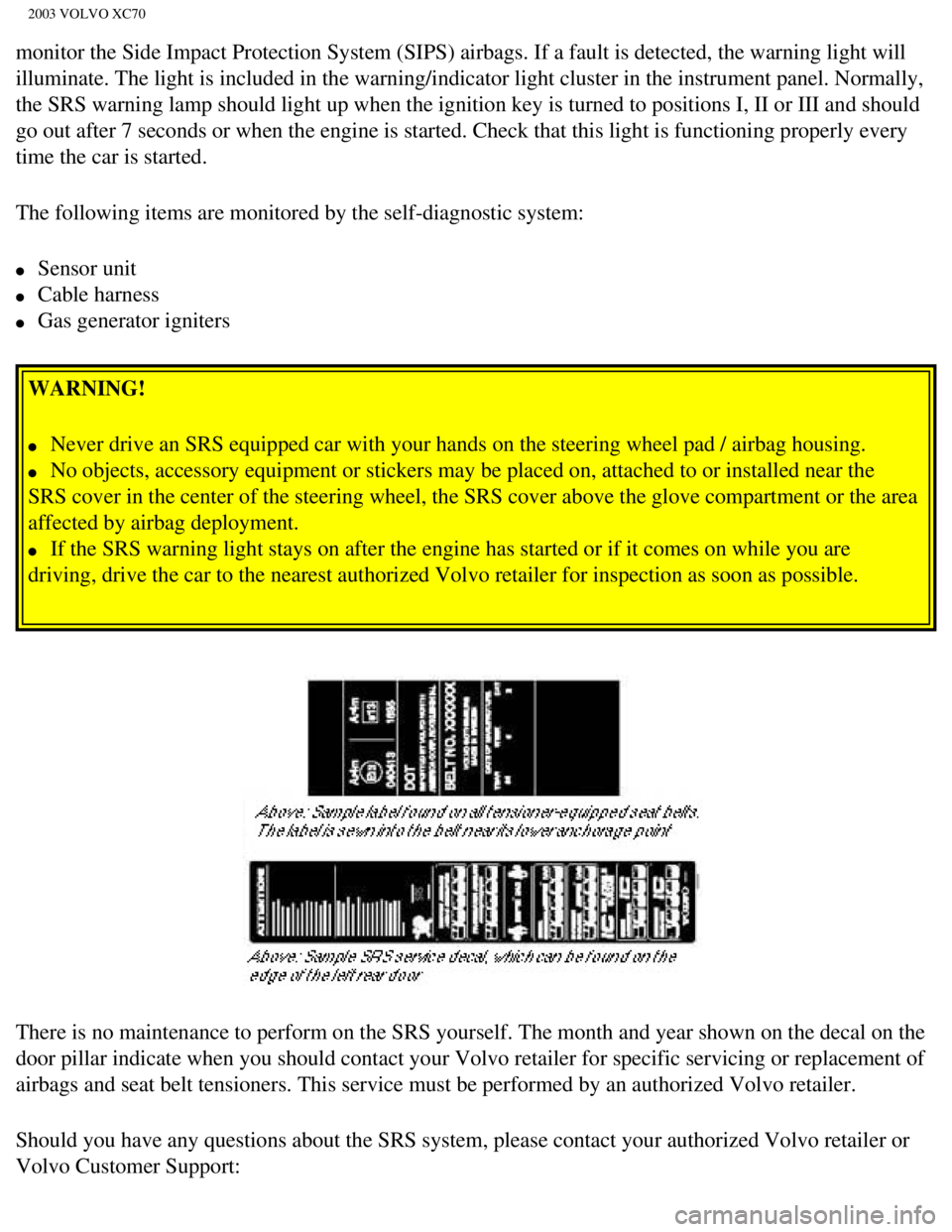
2003 VOLVO XC70
monitor the Side Impact Protection System (SIPS) airbags. If a fault i\
s detected, the warning light will
illuminate. The light is included in the warning/indicator light cluster\
in the instrument panel. Normally,
the SRS warning lamp should light up when the ignition key is turned to \
positions I, II or III and should
go out after 7 seconds or when the engine is started. Check that this li\
ght is functioning properly every
time the car is started.
The following items are monitored by the self-diagnostic system:
l Sensor unit
l Cable harness
l Gas generator igniters
WARNING!
l Never drive an SRS equipped car with your hands on the steering wheel pa\
d / airbag housing.
l No objects, accessory equipment or stickers may be placed on, attached t\
o or installed near the
SRS cover in the center of the steering wheel, the SRS cover above the g\
love compartment or the area
affected by airbag deployment.
l If the SRS warning light stays on after the engine has started or if it \
comes on while you are
driving, drive the car to the nearest authorized Volvo retailer for insp\
ection as soon as possible.
There is no maintenance to perform on the SRS yourself. The month and ye\
ar shown on the decal on the
door pillar indicate when you should contact your Volvo retailer for spe\
cific servicing or replacement of
airbags and seat belt tensioners. This service must be performed by an a\
uthorized Volvo retailer.
Should you have any questions about the SRS system, please contact your \
authorized Volvo retailer or
Volvo Customer Support:
file:///K|/ownersdocs/2003/2003_XC70/03xc70_01a.htm (7 of 17)12/30/200\
6 4:17:51 PM
Page 34 of 257
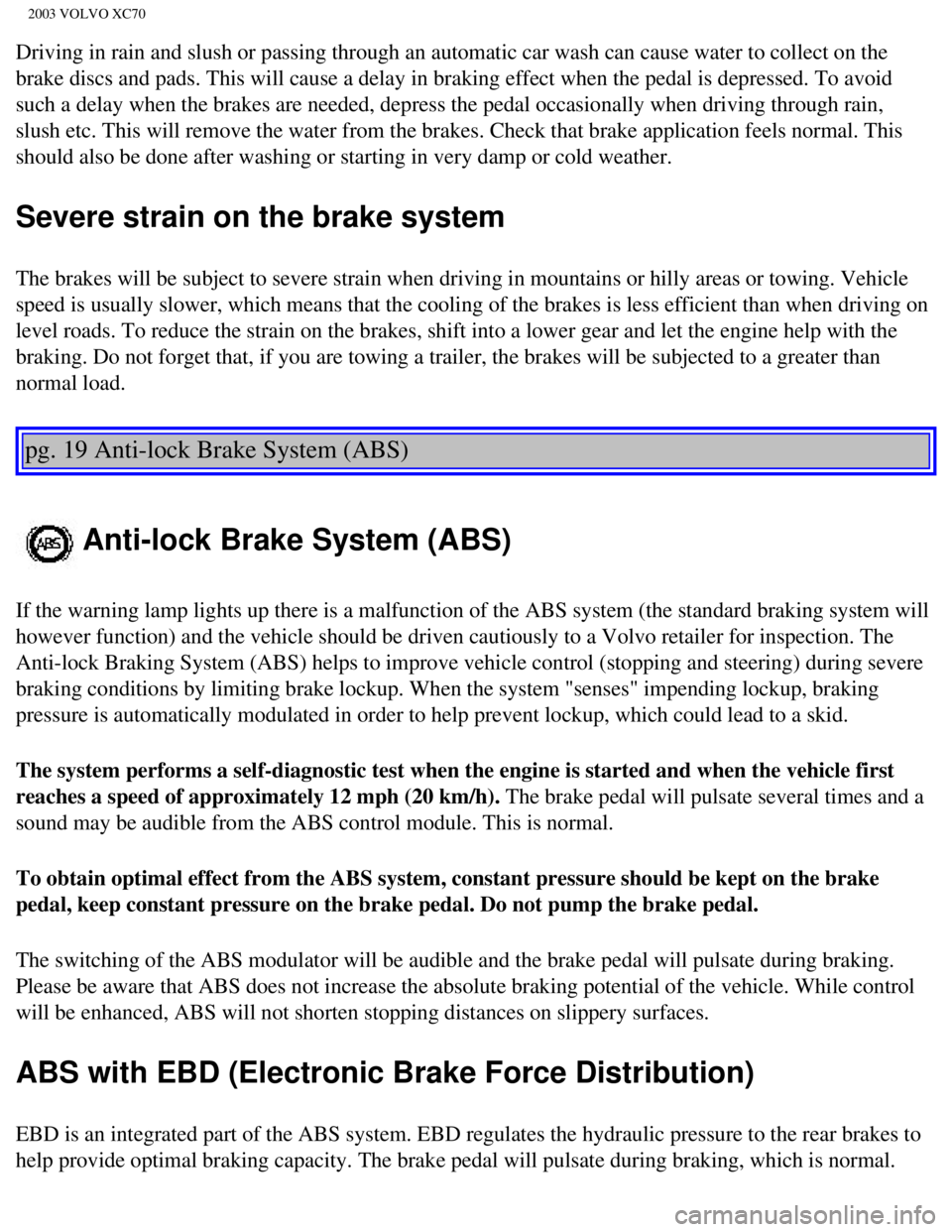
2003 VOLVO XC70
Driving in rain and slush or passing through an automatic car wash can c\
ause water to collect on the
brake discs and pads. This will cause a delay in braking effect when the\
pedal is depressed. To avoid
such a delay when the brakes are needed, depress the pedal occasionally \
when driving through rain,
slush etc. This will remove the water from the brakes. Check that brake \
application feels normal. This
should also be done after washing or starting in very damp or cold weath\
er.
Severe strain on the brake system
The brakes will be subject to severe strain when driving in mountains or\
hilly areas or towing. Vehicle
speed is usually slower, which means that the cooling of the brakes is l\
ess efficient than when driving on
level roads. To reduce the strain on the brakes, shift into a lower gear\
and let the engine help with the
braking. Do not forget that, if you are towing a trailer, the brakes wil\
l be subjected to a greater than
normal load.
pg. 19 Anti-lock Brake System (ABS)
Anti-lock Brake System (ABS)
If the warning lamp lights up there is a malfunction of the ABS system (\
the standard braking system will
however function) and the vehicle should be driven cautiously to a Volv\
o retailer for inspection. The
Anti-lock Braking System (ABS) helps to improve vehicle control (stop\
ping and steering) during severe
braking conditions by limiting brake lockup. When the system "senses" im\
pending lockup, braking
pressure is automatically modulated in order to help prevent lockup, whi\
ch could lead to a skid.
The system performs a self-diagnostic test when the engine is started an\
d when the vehicle first
reaches a speed of approximately 12 mph (20 km/h). The brake pedal will pulsate several times and a
sound may be audible from the ABS control module. This is normal.
To obtain optimal effect from the ABS system, constant pressure should b\
e kept on the brake
pedal, keep constant pressure on the brake pedal. Do not pump the brake \
pedal.
The switching of the ABS modulator will be audible and the brake pedal w\
ill pulsate during braking.
Please be aware that ABS does not increase the absolute braking potentia\
l of the vehicle. While control
will be enhanced, ABS will not shorten stopping distances on slippery su\
rfaces.
ABS with EBD (Electronic Brake Force Distribution)
EBD is an integrated part of the ABS system. EBD regulates the hydraulic\
pressure to the rear brakes to
help provide optimal braking capacity. The brake pedal will pulsate duri\
ng braking, which is normal.
file:///K|/ownersdocs/2003/2003_XC70/03xc70_01b.htm (11 of 14)12/30/20\
06 4:17:52 PM
Page 35 of 257
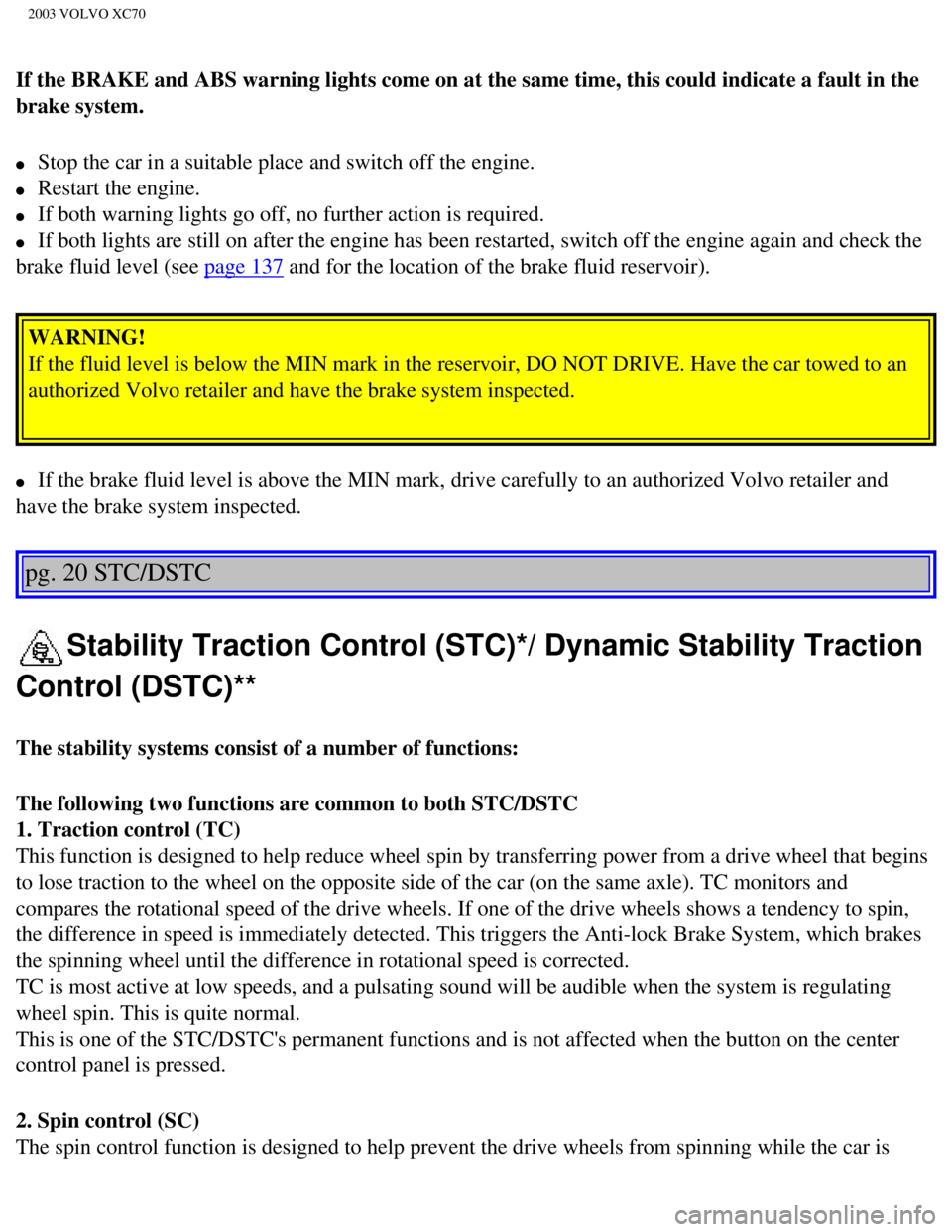
2003 VOLVO XC70
If the BRAKE and ABS warning lights come on at the same time, this could\
indicate a fault in the
brake system.
l Stop the car in a suitable place and switch off the engine.
l Restart the engine.
l If both warning lights go off, no further action is required.
l If both lights are still on after the engine has been restarted, switch \
off the engine again and check the
brake fluid level (see
page 137 and for the location of the brake fluid reservoir).
WARNING!
If the fluid level is below the MIN mark in the reservoir, DO NOT DRIVE.\
Have the car towed to an
authorized Volvo retailer and have the brake system inspected.
l If the brake fluid level is above the MIN mark, drive carefully to an au\
thorized Volvo retailer and
have the brake system inspected.
pg. 20 STC/DSTC
Stability Traction Control (STC)*/ Dynamic Stability Traction
Control (DSTC)**
The stability systems consist of a number of functions:
The following two functions are common to both STC/DSTC
1. Traction control (TC)
This function is designed to help reduce wheel spin by transferring powe\
r from a drive wheel that begins
to lose traction to the wheel on the opposite side of the car (on the s\
ame axle). TC monitors and
compares the rotational speed of the drive wheels. If one of the drive w\
heels shows a tendency to spin,
the difference in speed is immediately detected. This triggers the Anti-\
lock Brake System, which brakes
the spinning wheel until the difference in rotational speed is corrected\
.
TC is most active at low speeds, and a pulsating sound will be audible w\
hen the system is regulating
wheel spin. This is quite normal.
This is one of the STC/DSTC's permanent functions and is not affected wh\
en the button on the center
control panel is pressed.
2. Spin control (SC)
The spin control function is designed to help prevent the drive wheels f\
rom spinning while the car is
file:///K|/ownersdocs/2003/2003_XC70/03xc70_01b.htm (12 of 14)12/30/20\
06 4:17:52 PM
Page 37 of 257
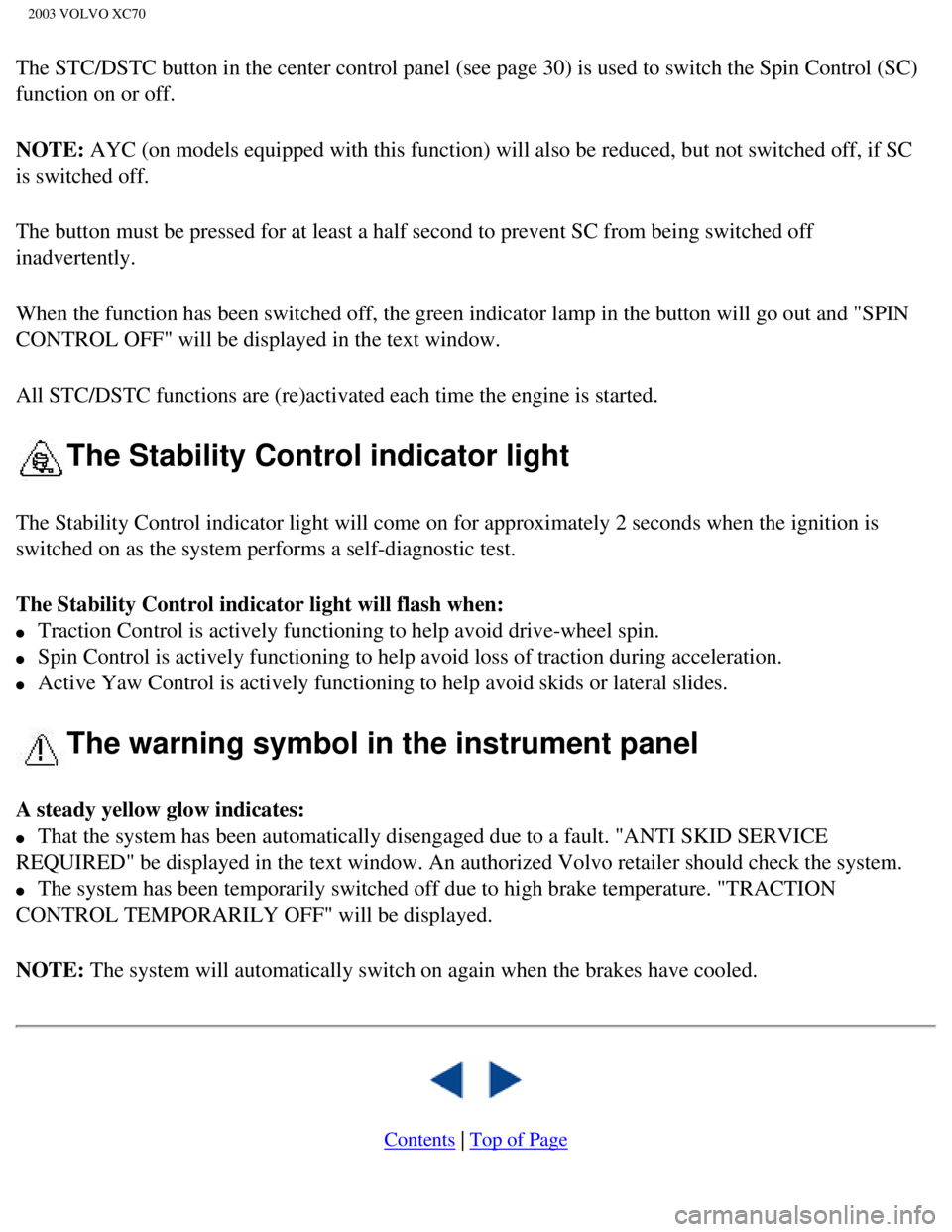
2003 VOLVO XC70
The STC/DSTC button in the center control panel (see page 30) is used \
to switch the Spin Control (SC)
function on or off.
NOTE: AYC (on models equipped with this function) will also be reduced, but\
not switched off, if SC
is switched off.
The button must be pressed for at least a half second to prevent SC from\
being switched off
inadvertently.
When the function has been switched off, the green indicator lamp in the\
button will go out and "SPIN
CONTROL OFF" will be displayed in the text window.
All STC/DSTC functions are (re)activated each time the engine is start\
ed.
The Stability Control indicator light
The Stability Control indicator light will come on for approximately 2 s\
econds when the ignition is
switched on as the system performs a self-diagnostic test.
The Stability Control indicator light will flash when:
l Traction Control is actively functioning to help avoid drive-wheel spin.\
l Spin Control is actively functioning to help avoid loss of traction duri\
ng acceleration.
l Active Yaw Control is actively functioning to help avoid skids or latera\
l slides.
The warning symbol in the instrument panel
A steady yellow glow indicates:
l That the system has been automatically disengaged due to a fault. "ANTI \
SKID SERVICE
REQUIRED" be displayed in the text window. An authorized Volvo retailer \
should check the system.
l The system has been temporarily switched off due to high brake temperatu\
re. "TRACTION
CONTROL TEMPORARILY OFF" will be displayed.
NOTE: The system will automatically switch on again when the brakes have cool\
ed.
Contents | Top of Page
file:///K|/ownersdocs/2003/2003_XC70/03xc70_01b.htm (14 of 14)12/30/20\
06 4:17:52 PM
Page 42 of 257

2003 VOLVO XC70
information.
If the engine temperature remains high, check coolant level - see
page 131.
4 Trip odometer/reset button
The trip odometer is used for measuring shorter distances. The last digi\
t indicates 1/10 mile/kilometer. Press
the button quickly to toggle between trip odometers 1 and 2. Hold in the\
button for more than 2 seconds to
reset.
5 Odometer
6 Speedometer
7 General warning light (see
page 28).
8 High beam indicator light
9 Tachometer
Indicates engine speed in thousands of rpm. Do not drive for long with t\
he needle in the red section. The
engine has an built-in function preventing too high an engine speed. Whe\
n this function operates, you may
discern some pulsation, which is normal.
10 Gear and driving mode indicator The currently selected driving mode is displayed here. If you use the
Geartronic function on the automatic transmission, the currently selecte\
d gear will be displayed.
11 Ambient temperature indicator
This display indicates the air temperature outside your car. A "snowflak\
e" symbol in the text window is
displayed when the temperature is in the range of 23 - 36° F (-5 - +\
2° C).
Please note that this symbol does not indicate a fault with your car.
At low speeds or when the car is not moving, the temperature readings ma\
y be slightly higher than the actual
ambient temperature.
12 Clock/reset button
Turn the button to adjust the clock.
13 Fuel gauge
The fuel tank holds approximately 18.5 US gals (70 liters) or 19 US ga\
ls (72 liters) on models equipped with
All Wheel Drive.
When the warning light comes on there are approximately 1.8 US gal. (8 \
liters) of fuel remaining.
file:///K|/ownersdocs/2003/2003_XC70/03xc70_02a.htm (5 of 13)12/30/200\
6 4:17:53 PM
Page 44 of 257

2003 VOLVO XC70
Brake failure warning light
If the light comes on while driving or braking, stop immediately, open t\
he hood and check the brake
fluid level in the reservoir. See
page 134 for reservoir position and page 137 for instructions.
Canadian models are equipped with this warning light:
Oil pressure warning light
If the light comes on while driving, stop the car and then stop the engi\
ne immediately and check the
engine oil level. See
page 135. If the light stays on after restart, have the car towed to the nearest\
authorized
Volvo retailer. After hard driving, the light may come on occasionally w\
hen the engine is idling. This is
normal, provided it goes off when the engine speed is increased.
Parking brake reminder light
This light will be on when the parking brake (hand brake) is applied. \
The parking brake lever is situated
between the front seats.
Canadian models are equipped with this warning light:
Generator warning light
If the light comes on while the engine is running, have the charging sys\
tem checked.
* Rear fog light, if used, and trailer turn signal, if towing a trailer,\
will go on while driving.
pg. 29 Indicator and warning lights
file:///K|/ownersdocs/2003/2003_XC70/03xc70_02a.htm (7 of 13)12/30/200\
6 4:17:53 PM
Page 45 of 257
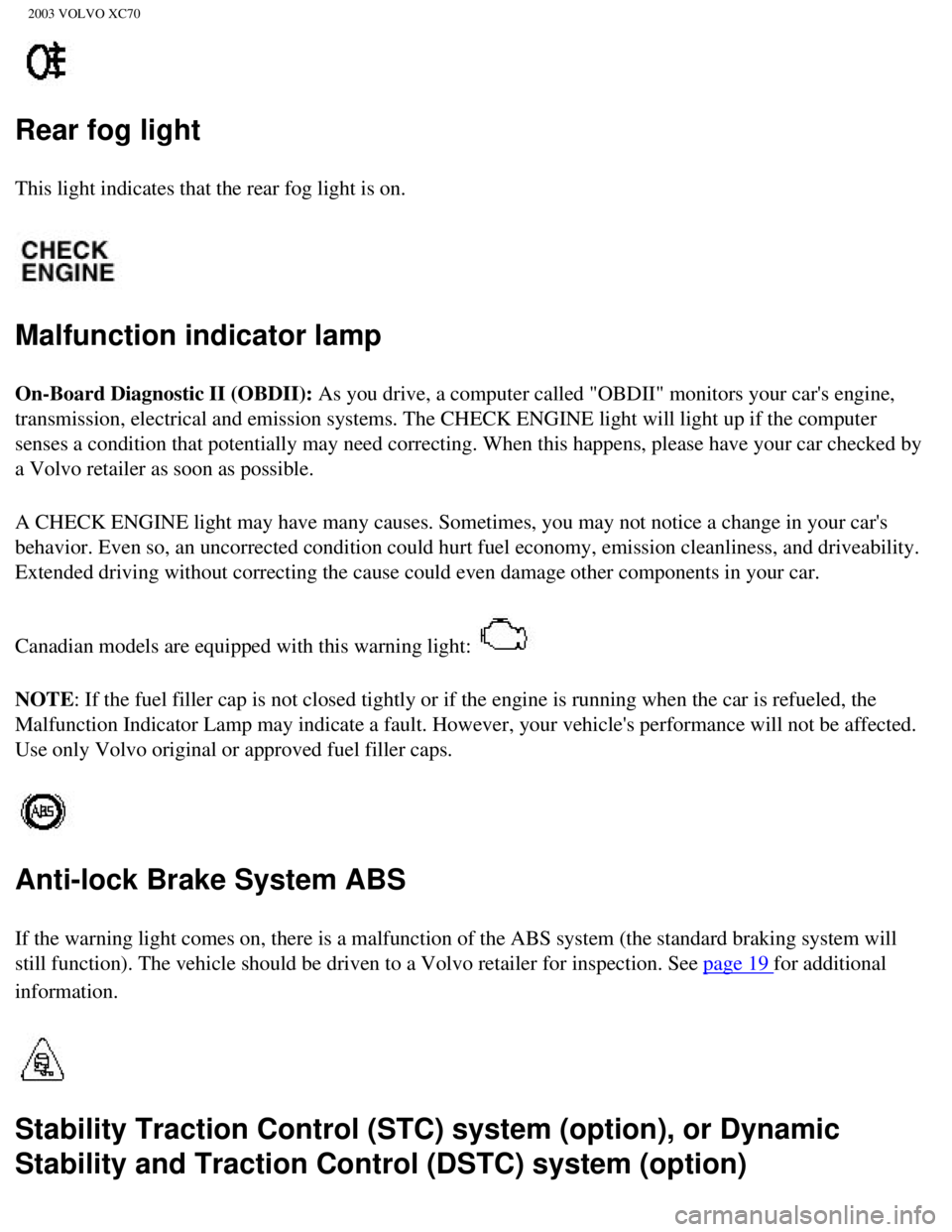
2003 VOLVO XC70
Rear fog light
This light indicates that the rear fog light is on.
Malfunction indicator lamp
On-Board Diagnostic II (OBDII): As you drive, a computer called "OBDII" monitors your car's engine,
transmission, electrical and emission systems. The CHECK ENGINE light wi\
ll light up if the computer
senses a condition that potentially may need correcting. When this happe\
ns, please have your car checked by
a Volvo retailer as soon as possible.
A CHECK ENGINE light may have many causes. Sometimes, you may not notice\
a change in your car's
behavior. Even so, an uncorrected condition could hurt fuel economy, emi\
ssion cleanliness, and driveability.
Extended driving without correcting the cause could even damage other co\
mponents in your car.
Canadian models are equipped with this warning light:
NOTE: If the fuel filler cap is not closed tightly or if the engine is runni\
ng when the car is refueled, the
Malfunction Indicator Lamp may indicate a fault. However, your vehicle's\
performance will not be affected.
Use only Volvo original or approved fuel filler caps.
Anti-lock Brake System ABS
If the warning light comes on, there is a malfunction of the ABS system \
(the standard braking system will
still function). The vehicle should be driven to a Volvo retailer for i\
nspection. See
page 19 for additional
information.
Stability Traction Control (STC) system (option), or Dynamic
Stability and Traction Control (DSTC) system (option)
file:///K|/ownersdocs/2003/2003_XC70/03xc70_02a.htm (8 of 13)12/30/200\
6 4:17:53 PM
Page 125 of 257

2003 VOLVO XC70
Winter driving 104
Long distance trips 105
Three-way catalytic converter 106
pg. 84 Fuel requirements
Fuel requirements
Octane rating: Volvo engines are designed for optimum performance on unleaded premium\
gasoline
with an octane rating AKI of 91, or above. AKI (ANTI KNOCK INDEX) is a\
n average of the Research
Octane Number, RON, and the Motor Octane Number, MON. (RON + MON/2). T\
he minimum octane
requirement is AKI 87 (RON 91).
Deposit control gasoline (detergent additives)
Volvo recommends the use of gasoline containing deposit control additive\
s. These additives have shown
to be effective in keeping injectors and intake valves clean. Consistent\
use of deposit control gasolines
will help ensure good driveability and fuel economy. If you are not sure\
whether the gasoline contains
deposit control additives, check with the service station operator.
Unleaded fuel
Each Volvo has a three-way catalytic converter and must use only unleade\
d gasoline. U.S. and Canadian
regulations require that pumps delivering unleaded gasoline be labelled \
"UNLEADED". Only these
pumps have nozzles which fit your car's filler inlet. It is unlawful to \
dispense leaded fuel into a vehicle
labelled "unleaded gasoline only". Leaded gasoline damages the three-way\
catalytic converter and the
heated oxygen sensor system. Repeated use of leaded gasoline will lessen\
the effectiveness of the
emission control system and could result in loss of emission warranty co\
verage. State and local vehicle
inspection programs will make detection of misfueling easier, possibly r\
esulting in emission test failure
for misfueled vehicles.
NOTE: Some U.S. and Canadian gasolines contain an octane enhancing additive ca\
lled methyl-
cyclopentadienyl manganese tricarbonyl (MMT). If such fuels are used, \
your Emission Control System
performance may be affected, and the Check Engine light (malfunction in\
dicator lamp) located on your
instrument panel may light. If this occurs, please return your vehicle t\
o an authorized Volvo retailer for
service.
Gasoline containing alcohol and ethers
"Oxygenated fuels"
file:///K|/ownersdocs/2003/2003_XC70/03xc70_06a.htm (2 of 22)12/30/200\
6 4:17:59 PM